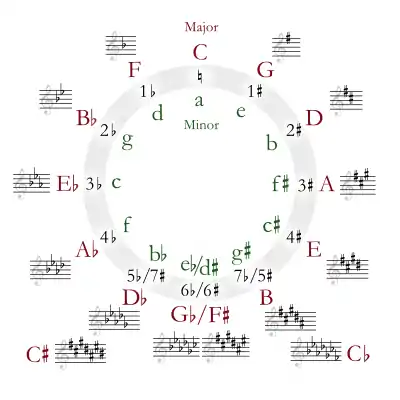| Relative key | A major |
|---|---|
| Parallel key | F-sharp major |
| Dominant key | C-sharp minor |
| Subdominant | B minor |
| Component pitches | |
| F♯, G♯, A, B, C♯, D, E | |
F-sharp minor is a minor scale based on F♯, consisting of the pitches F♯, G♯, A, B, C♯, D, and E. Its key signature has three sharps. Its relative major is A major and its parallel major is F-sharp major (or enharmonically G-flat major).
The F-sharp natural minor scale is:
Changes needed for the melodic and harmonic versions of the scale are written in with accidentals as necessary. The F-sharp harmonic minor and melodic minor scales are:
Scale degree chords
- Tonic - F-sharp minor
- Supertonic - G-sharp diminished
- Mediant - A major
- Subdominant - B minor
- Dominant - C-sharp minor
- Submediant - D major
- Subtonic - E major
Music in F-sharp minor
Very few symphonies are written in this key, Haydn's Farewell Symphony being one famous example. George Frederick Bristow and Dora Pejačević also wrote symphonies in this key.
The few concerti written in this key are usually written for the composer himself to play, including Rachmaninoff's Piano Concerto No. 1, Scriabin's Piano Concerto, Wieniawski's Violin Concerto No. 1, Vieuxtemps's Violin Concerto No. 2, Bernhard Romberg's Cello Concerto Op. 30 and Koussevitzky's Double Bass Concerto.
In addition to the Farewell Symphony, Haydn's Piano Trio No. 40 (Hob. XV:26) and String Quartet Op. 50, No. 4 are in F-sharp minor.
More prominent piano pieces written in F-sharp minor include Dussek's Sonata in F sharp minor, Op. 61 ('Élégie Harmonique'), Schumann's Sonata No. 1 in F-sharp minor (1833-35), Chopin's Polonaise in F♯ minor, Scriabin's Third Sonata, and Ravel's Sonatine. The slow movement of Beethoven's Hammerklavier piano sonata is written in this key. Wagner too wrote a fantasy in F-sharp minor (WWV 22).
Handel set the sixth of his eight harpsichord suites of 1720 in F-sharp minor. Aside from a prelude and fugue from each of the two books of The Well-Tempered Clavier, Bach's only other work in F-sharp minor is the Toccata BWV 910. Mozart's only composition in this key is the second movement to his Piano Concerto No. 23 in A major.[1] F-sharp minor is sometimes used as the parallel minor of G-flat major, for example in the ending of Alkan's op. 35 nro 10 in G-flat major. F-sharp minor is more practical to use with three sharps while G-flat major's real parallel minor, G-flat minor, would have nine flats. (All seven flats and the first two flats double-flatted.)
Notable classical compositions in F-sharp minor
- Charles-Valentin Alkan
- Johannes Brahms
- Piano Sonata No. 2, Op. 2
- Hungarian Dances Nos. 5 & 17 (original version for 4-hands )
- Frédéric Chopin
- Muzio Clementi
- Piano Sonata in F-sharp minor, Op. 25/5
- Ernst von Dohnányi
- George Enescu
- Piano Sonata No. 1, Op. 24, No. 1 (1924)
- Gabriel Fauré
- Pavane, Op. 50
- César Franck
- Joseph Haydn
- Symphony No. 45 (Farewell)
- Piano Trio No. 40, Hob. XV:26
- Johann Nepomuk Hummel
- Felix Mendelssohn
- Fantasy in F-sharp minor, Op. 28, ("Sonate Éccossaise")
- Hélène de Montgeroult
- Piano Sonata in F-sharp minor, Op. 5/3
- Ignaz Moscheles
- Sonate mélancolique in F-sharp minor, Op. 49
- Sergei Rachmaninoff
- Piano Concerto No. 1, Op. 1
- Prelude in F-sharp minor No. 1, Op. 23
- Maurice Ravel
- Franz Schubert
- Piano Sonata in F-sharp minor, D 571 (incomplete)
- Robert Schumann
- Piano Sonata No. 1, Op. 11
- Alexander Scriabin
- Piano Concerto, Op. 20
- Piano Sonata No. 3, Op. 23
- Dmitri Shostakovich
- Prelude and Fugue No. 8, Op. 87
- String Quartet No. 7, Op. 108
- Igor Stravinsky
- Piano Sonata (1903–04)
- Georg Philipp Telemann
- Henryk Wieniawski
- Violin Concerto No. 1, Op. 14
References
- ↑ Hopkins, Antony (1964). Talking About Concertos. London: Heinemann. p. 30.
Further reading
- Anthony Morris, "Symphonies, Numbers and Keys" in Bob's Poetry Magazine, III.3, March 2006.
External links
 Media related to F-sharp minor at Wikimedia Commons
Media related to F-sharp minor at Wikimedia Commons




